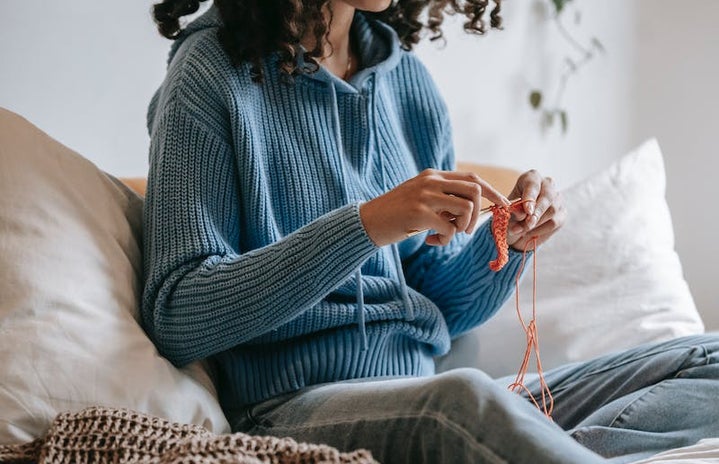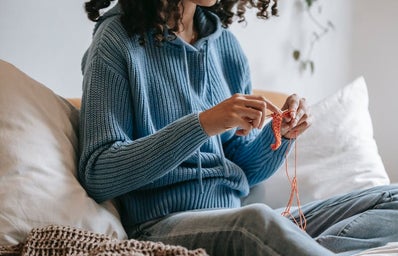I started 2024 acutely aware of the lack of hobbies I had in my life. One can only scroll through Instagram reels for so long until they don’t cut it anymore. But one day, the cutest woven beanie popped up in my feed and I thought, “I could make that.” So I did. A few YouTube tutorials and trips to JOANN Fabric and Crafts later, I had myself a wonky, uneven winter hat.
Since I made that hat in January, I’ve been obsessed with crocheting. In case you’re unfamiliar, it’s the art of making textiles by looping yarn together using a hook. It’s like knitting, but it involves one hooked needle instead of two straight ones. It’s the perfect hobby to shut your brain down for a while, and you get a cute, soft handmade item at the end of it.
As with any craft, the hardest part is getting started. Crocheting’s been quite the learning process for me, and I’m still only a beginner. When I picked it up, I dove right in. I went to the craft store with no plans and left with some hooks, yarn, and a whole lot of confusion.
So if you’re interested in learning how to crochet, want to make some unique garments, or just want to try a new hobby, here are a few tools you may want to know more about and everything I wish I had known when I started.
Yarn
Yarn is one of the most addictive parts of crocheting. The deeper you go into the hobby, the more yarn you find yourself buying with no future project in mind. Before you know it, you have more than you know what to do with. Don’t say I didn’t warn you.
The classic, oval-shaped yarn that most are familiar with is called a skein. It comes in all kinds of patterns, colors, and materials.
Yarn’s thickness, or weight, is measured on a scale from one (or lace) to seven (or jumbo). You can find a yarn’s weight on its paper label, along with its yardage and weight in grams. Weight four yarn is known as “worsted weight” and is the most common yarn you’ll find in stores. I’d recommend starting with it, as it’s the easiest to work with as a beginner.
One thing I found particularly confusing, and honestly still struggle with, is knowing how much yarn to buy. Projects go a lot faster when using thicker ones, but there’s usually less in a skein, meaning you may need to buy more than you think when using it. Alternatively, you need thinner yarn to finish a project, but there’s typically more in a skein. Not to mention, different stitches and hook sizes may require more or less.
The confusing thickness and thinness of yarn make weight in grams your best measurement for how much to buy. Most projects will tell you how many grams of it you’ll need, and this is going to be your most accurate answer. Inevitably, there will be times when you buy too little and it ends up out of stock for a while. I’ve fallen victim to this far too many times. The best solution is to start a new project while you wait and let the cycle repeat itself.
Hooks
Crochet hooks are about to become your best friend and worst enemy. Never did I think I’d be concerned about carpal tunnel syndrome at 20 years old, but hooks are essential to the craft and come in a variety of different options.
I’ve collected a few different kinds of hooks, from the standard to some with grippy or chunky handles. I haven’t found a major difference, so feel free to experiment and see what works for you. If you’re stuck on what size you need, every skein will tell you what hook you should use on their paper labels.
A common issue with beginners is pulling the yarn too tight, which makes it difficult to complete a stitch. A solution that has helped me is buying a hook slightly larger than what the label recommends. So if a yarn calls for a five-millimeter hook, I’ll use a five-and-a-half-millimeter hook instead.
Tutorials
At this point, you may be a little lost. I’ve thrown out some terms that may be unfamiliar, and unfortunately, I can’t demonstrate them through an article. That’s why I also recommend starting with a YouTube tutorial! There are so many helpful videos to choose from, and you can rewind and slow them down however you like.
If there’s ever a tutorial with a step you’re confused by, I can almost guarantee another one exists that breaks it down even more. I used one to make my first-ever project, and it taught me the most basic steps of crochet including slipknots, chains, and single crochets. After mastering a beanie, I moved on to sweater vests, granny squares, and slouchy sweaters.
Additional Tools
Additional tools I recommend for crochet are yarn needles and stitch markers. While many projects for beginners don’t need them, you’ll likely find a project that requires them once you’re fully crochet-obsessed (which will happen in no time). Yarn needles are used for sewing separate pieces of a project together, and stitch markers are used for keeping count of your stitches during more complex projects.
Understanding crochet materials and following along with tutorials can help you learn many basic techniques that you can experiment with on your own. Before you know it, you’ll be free-handing projects with ease! Happy crafting!
Want to see more HCFSU? Be sure to like us on Facebook and follow us on Instagram, Twitter, TikTok, and Pinterest!


